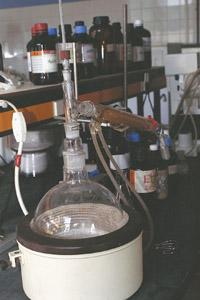What are Polymers?
1999/11/01 Roa Zubia, Guillermo - Elhuyar Zientzia Iturria: Elhuyar aldizkaria
Polymers are giant molecular structures formed by the union of small molecules. Just as a wall is constructed through the binding of bricks, for the synthesis of polymers small molecules called "monomers" are used. Among these macrostructures (macromolecules) there are many essential molecules for life, proteins, nucleic acids, etc. For example, the hemoglobin that carries oxygen in the blood, the famous DNA that contains the genetic information or the natural macromolecules of cellulose that form the traditional paper.
Human beings have also learned to build new macromolecules. From some tropical plants, natural rubber was extracted. In the nineteenth century it was discovered that the molecule called isoprene could be silenced. In addition, from the isoprene, other substances were obtained in the form of rubber. The other polymer that was learned to transform at the same time was cellulose nitrate. Consequently, the new material obtained was called “celluloid”.

But the first to open the door to synthetic polymers was Belgian Leo Hendrick Baekeland (1863-1944). In 1906 Baekeland reacted phenol and formaldehyde and formed the resin. By heating the obtained resin it could be converted into plastic and pour into a mold producing an object in any form. This resin was called "baquelita".
Bakelita was integrated into all areas of technology and began the "Plastic Age". Research on the synthesis of these compounds was rapidly extended. Precisely, one of the highlights of this century has been the development of the synthesis of artificial polymers in the world of Chemistry.
Hermann Staudinger was the first to propose a polymer structure based on molecular chains and networks. The following experiments confirmed this proposal. In 1953 he received the Nobel Prize for his work with polymers. The successive union of monomers allows to build molecular chains. On the other hand, through the use of special monomers, branch chains or three-dimensional networks can be formed. In this way, compounds of different properties can be formed depending on their length and composition. The chemical and physical behavior of these molecules is different from other substances. Therefore, a new field of science has been consolidated at all levels.
Polymers are the majority of things that are common in everyday life. Known as plastics, resins, latex, paints, glues, varnishes, fabrics, teflon used in the manufacture of pans or PVC that has generated controversy are some of the polymers that today are indispensable.

Gai honi buruzko eduki gehiago
Elhuyarrek garatutako teknologia




